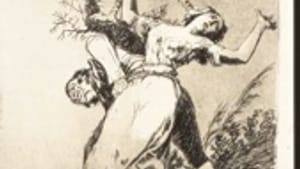Stay in the Loop
BSR publishes on a weekly schedule, with an email newsletter every Wednesday and Thursday morning. There’s no paywall, and subscribing is always free.
Goya's 'Los Caprichos' at Arthur Ross Gallery

Goya the satirist, in a world of monsters
ANDREW MANGRAVITE
Like the fellow in the old Chinese curse, Francisco Goya y Lucientes (1746-1828) lived in “interesting times.” The long reign of Reason, with its insistence that even if people were not basically good, their rottenness was at least comprehensible, was drawing to a close, and Romanticism was waiting in the wings with more monsters, real and imagined, than Pandora had hidden away in her little box.
Through January 7, Philadelphians will be privileged to view a complete series of Goya prints, “Los Caprichos.” These “caprices” are designed to illustrate Goya’s central thesis: that “the sleep of reason produces monsters.” Goya recognized that he lived in a time in which “sleeping sickness” was endemic and his prints— humorous, grotesque, horrific and all-too-human— were designed both to greet and mock the dawning age of monsters.
A visual novel of folly and superstition
To be sure, “Los Caprichos” is not as gruesome as “The Disasters of War,” Goya’s depiction of Napoleon Bonaparte’s military adventure in Spain, nor as mysterious and haunting as the prints in “Los Proverbios.” But because the “Caprichos” is a longer series of prints, and its captions play a more integral role in understanding the work, it reads like a visual novel on the themes of Folly and Superstition. (Goya’s greatness perhaps lies in the fact that he is at once both a great Classicist and a great Romantic.)
If “The Disasters of War” offers us our best look at Goya the anguished and outraged observer, and if “Los Proverbios” offers our best look at Goya the visionary poet— creator of such archetypal paintings as “The Colossus” and “Saturn Devouring one of his Sons”— “Los Caprichos” is our finest introduction to Goya the satirist.
Witches without broomsticks
His frontispiece self-portrait shows the artist as a man at once aloof and somewhat sad. He’s seen a lot to depress him. Viewing “Los Caprichos,” you’ll see donkeys dressed like men, witches flying through the air (with and without broomsticks), lazy monks, ugly old men bartering for pretty young wives, all of it commented upon in elegant and sardonic captions. Best of all, because the set on display (from the collection of Mr. and Mrs. Arthur Ross) is an early set, you’ll see the images much as Goya had intended them to be seen. (Sadly prints wear over their lifetimes, and later sets will lose much of the sharpness and vibrancy of the earlier ones.)
This is a show that richly deserves to be seen. And as usual, the Arthur Ross staff is to be commended for producing a splendid and informative little accompanying booklet.
For another review of this exhibit by Robert Zaller, click here.
ANDREW MANGRAVITE
Like the fellow in the old Chinese curse, Francisco Goya y Lucientes (1746-1828) lived in “interesting times.” The long reign of Reason, with its insistence that even if people were not basically good, their rottenness was at least comprehensible, was drawing to a close, and Romanticism was waiting in the wings with more monsters, real and imagined, than Pandora had hidden away in her little box.
Through January 7, Philadelphians will be privileged to view a complete series of Goya prints, “Los Caprichos.” These “caprices” are designed to illustrate Goya’s central thesis: that “the sleep of reason produces monsters.” Goya recognized that he lived in a time in which “sleeping sickness” was endemic and his prints— humorous, grotesque, horrific and all-too-human— were designed both to greet and mock the dawning age of monsters.
A visual novel of folly and superstition
To be sure, “Los Caprichos” is not as gruesome as “The Disasters of War,” Goya’s depiction of Napoleon Bonaparte’s military adventure in Spain, nor as mysterious and haunting as the prints in “Los Proverbios.” But because the “Caprichos” is a longer series of prints, and its captions play a more integral role in understanding the work, it reads like a visual novel on the themes of Folly and Superstition. (Goya’s greatness perhaps lies in the fact that he is at once both a great Classicist and a great Romantic.)
If “The Disasters of War” offers us our best look at Goya the anguished and outraged observer, and if “Los Proverbios” offers our best look at Goya the visionary poet— creator of such archetypal paintings as “The Colossus” and “Saturn Devouring one of his Sons”— “Los Caprichos” is our finest introduction to Goya the satirist.
Witches without broomsticks
His frontispiece self-portrait shows the artist as a man at once aloof and somewhat sad. He’s seen a lot to depress him. Viewing “Los Caprichos,” you’ll see donkeys dressed like men, witches flying through the air (with and without broomsticks), lazy monks, ugly old men bartering for pretty young wives, all of it commented upon in elegant and sardonic captions. Best of all, because the set on display (from the collection of Mr. and Mrs. Arthur Ross) is an early set, you’ll see the images much as Goya had intended them to be seen. (Sadly prints wear over their lifetimes, and later sets will lose much of the sharpness and vibrancy of the earlier ones.)
This is a show that richly deserves to be seen. And as usual, the Arthur Ross staff is to be commended for producing a splendid and informative little accompanying booklet.
For another review of this exhibit by Robert Zaller, click here.
Sign up for our newsletter
All of the week's new articles, all in one place. Sign up for the free weekly BSR newsletters, and don't miss a conversation.
